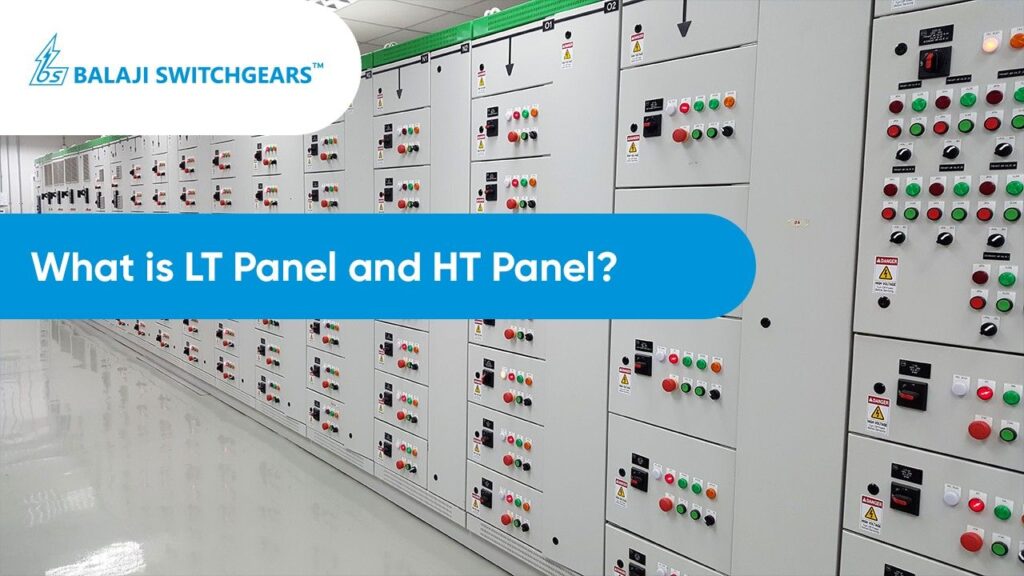In electrical distribution, LT and HT panels play a crucial role in managing power across industries, commercial buildings, and large infrastructures. These electrical control panels ensure the safe and efficient distribution of electricity, protect equipment, and maintain operational stability. If you’re in the electrical industry or planning to set up an industrial unit, understanding these panels is essential.
What is an LT Panel?
LT (Low Tension) panels are low voltage switchgear systems designed for electrical distribution at voltages below 1kV (typically 415V or 230V). These panels manage power in industrial and commercial spaces, ensuring safe and controlled electricity supply.
Functions of LT Panels:
- Distribution of power to different sections of a building or industrial unit.
- Protection against short circuits and overloads.
- Control of power supply to machines and equipment.
- Enhancement of power efficiency and safety.
Types of LT Panels:
- Power Control Center (PCC): Regulates and distributes power from the main source to different areas.
- Motor Control Center (MCC): Used for motor protection and control in industries.
- Automatic Power Factor Correction (APFC) Panel: Maintains power factor to reduce energy consumption and penalties.
- Distribution Panel: Distributes power to different sections of a building or industrial setup.
- Synchronization Panel: Helps in synchronizing multiple power sources like generators.
Where are LT Panels Used?
- Industrial manufacturing units
- Commercial buildings and office complexes
- Hospitals and educational institutions
- Residential societies
- Data centers and IT parks
What is an HT Panel?
HT (High Tension) panels are electrical distribution panels that operate at high voltages, typically above 3.3kV and up to 33kV. These panels are used to manage and control the high-voltage power supply from transformers to industrial and commercial establishments.
Functions of HT Panels:
- Distribute high voltage electricity safely.
- Protect equipment from voltage fluctuations and electrical faults.
- Act as a control mechanism for power stations and substations.
- Ensure efficient and reliable power transmission.
Types of HT Panels:
- Vacuum Circuit Breaker (VCB) Panel: Used for medium-voltage applications, providing efficient circuit breaking and protection.
- SF6 Circuit Breaker Panel: Uses sulfur hexafluoride gas for insulation and circuit breaking in high-voltage applications.
- Ring Main Unit (RMU): Provides uninterrupted power supply. It integrates circuit breakers, isolators, and transformers into a single unit, simplifying system design and reducing space requirements.
Where are HT Panels Used?
- Power generation plants
- Large industrial setups
- Substations and transformers
- Commercial complexes with high power demand
- Public utility networks
Difference Between LT Panel and HT Panel
| Feature | LT Panel | HT Panel |
| Voltage Level | Operates at voltages below 1kV | Operates at voltages above 3.3kV |
| Usage | Used in commercial buildings and small industries | Used in large industries and power stations |
| Components | Circuit breakers, relays, switches | Transformers, VCBs, SF6 breakers |
| Safety | Less complex, requires basic safety measures | More advanced, requires specialized safety protocols |
| Installation | Easier and cost-effective | Complex and requires higher investment |
How to Choose the Right Electrical Panel for Your Needs?
Choosing between an LT panel and an HT panel depends on various factors such as:
- Power Requirement: If your setup requires high voltage supply, an HT panel is necessary. For low voltage distribution, an LT panel is sufficient.
- Industry Type: Manufacturing plants, large commercial spaces, and power generation units require HT panels, whereas small industries, office buildings, and residential areas can function with LT panels.
- Safety and Compliance: HT panels require higher safety standards and compliance due to high voltage handling. LT panels have relatively simpler compliance requirements.
- Budget and Maintenance: HT panels involve higher costs in installation and maintenance, whereas LT panels are more cost-effective and easier to maintain.
Conclusion
Both LT panels and HT panels are essential for different electrical applications, depending on voltage needs and usage. These electrical control panels ensure smooth and safe power distribution, making them an integral part of modern electrical infrastructure.
At Balaji Switchgears, we specialize in providing high-quality low voltage switchgear and electrical control panel solutions. With a commitment to safety, efficiency, and industry-leading technology, we offer customized panels to meet the unique power distribution needs of businesses.
For expert consultation and reliable power distribution solutions, Contact Balaji Switchgears today!

